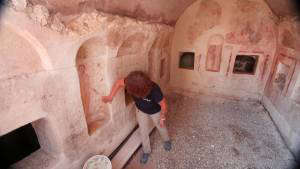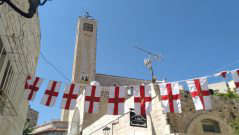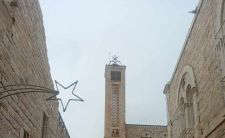
The Nymphs and Goddesses Rise to Life
The Nymphs and Goddesses Rise to Life:
Wall paintings of stunning beauty from the Roman period discovered in Ashkelon are being revealed and made publicly accessible for the first time
These paintings decorating ancient tombs of wealthy people were discovered decades ago, but few people ever saw them. Now, they are preserved near the city’s marina by Israel Antiquities Authority conservation experts, funded by the Ashkelon Municipality, as part of the overall development of the city’s many archaeological gems
Two vaulted tombs, at least 1,700 years old, displaying magnificent wall paintings rarely found in Israel, of Greek mythological characters, people, plants and animals, will soon be revealed to the public for the first time. This work is one product of the broad cooperation between the Ashkelon Municipality and the Israel Antiquities Authority to develop and integrate the city’s exceptional heritage assets into its public areas, for the well-being of both residents and visitors.
These ancient vaulted structures are located near Ashkelon’s marina, in a public area situated in-between residential towers. The municipality decided to make the site publicly accessible, and consequently this previously-neglected area was turned into an inviting public garden containing the two tombs – even a mere glimpse inside immediately opens a window into an ancient and fascinating world.
Ashkelon Mayor, Tomer Glam, says: “Ashkelon is one of the world’s oldest cities, and as we shape and design the city's future, we ensure a place of honor to its glorious and rich past. In recent years we have made a real revolution in the realm of historical site preservation. We made sites accessible to the city's residents and to the general public, and then organized events and produced educational, cultural and touristic programs with the aim of connecting the city's history to its present. This is the appropriate moment to thank Deputy Mayor Miri Altit for her comprehensive professional work in this endeavor, and to thank the Israel Antiquities Authority for this cooperation of such immense importance, helping us position Ashkelon as Israel’s City of Antiquities.”
The site was found way back in the 1930s, about 300 meters from the beach; a sand-filled vaulted tomb. The tomb structure was excavated by a British expedition and dated to the early 4th century CE, and it is comprised of a hall with four adjacent burial troughs. This passageway is decorated by a range of paintings, impressive in quality and skill, and include depictions such as that of Demeter – the Greek mythological goddess of the earth and grain. Other images are of plants such as vines and grape clusters; different types of leaves and branches; and depictions of nymphs – mythological figures related to nature; their heads adorned with lotus plant wreaths, and holding pitchers from which water pours out. There are also various birds, deer; children picking bunches of grapes and gathering them into baskets; a figure playing Pan’s flute; and a
wide range of many other images – mostly notably, Medusa the Gorgon’s head— a monstrous female face with hair made of snakes. In Greek mythology, her look turned those who gazed on her to stone.
Another vaulted and decorated tomb in the public garden was relocated here from another Ashkelon site already in the 1990s, to ensure its preservation. This tomb, uncovered in the excavation of Dr. Elena Kogan-Zehavi—Israel Antiquities Authority, dates from the 2nd century CE. In the building’s center is a hall whose walls are decorated with colorful paintings of human figures, birds and other images from the animal and plant worlds. Around the hall are vaulted loculi, in which lead coffins were discoveredף decorated with human, animals and vegetative images.
In recent months, these structures and their decorations have been preserved through a complex process executed by Vladimir Bitman, David Kirakosian, Alexei Ronkin and Yoni Tirosh HaCohen, conservation department experts at the Israel Antiquities Authority. According to Mark Abrahami, head of the Israel Antiquities Authority’s art conservation branch, “Ancient wall paintings are usually not preserved in Israel’s humid climate. As the paintings were in a relatively closed structure it protected them, to some extent, for decades. Naturally, exposure of the centuries-old paint to air and moisture caused fading and weathering. We had to conduct a long and sensitive process to stop and repair the ravages of time and weathering. Some paintings had to be removed from the walls for thorough treatment in the Israel Antiquities Authority's conservation laboratories, until they were returned to the site. The other walls of the structure were cleaned, the pigments in the colors of the paintings were accentuated, and the entire building was strengthened and stabilized to preserve it for future generations."
In recent years, the Ashkelon Municipality has invested considerable resources in the care and development of the city’s ancient sites in cooperation with the Israel Antiquities Authority. Among other works, a large public park was opened in the new Wine City neighborhood, with an ancient industrial site at its heart. This complex includes winepresses and olive presses, warehouses, a bathhouse and more. A mosaic on Yekutiel Adam Street is also conserved and preserved right next to a playground, unique in that it incorporates archaeological elements. The well-known sarcophagus courtyard, a public display of dozens of impressive and rare items found throughout in the city, has been upgraded. A display of beautiful ancient artifacts was set up on Kadesh Boulevard, and more.
When the public garden is opened for the upcoming holidays, residents of Ashkelon, Israeli visitors and tourists will be able to gaze in wonder and enjoy the beauty of these rare paintings and thus learn about the fascinating past history of this bustling modern port city.
According to Eli Escusido, Israel Antiquities Authority Director, “The city of Ashkelon is one of the first cities in Israel that are wisely acting to leverage the enormous potential in values and aesthetics embodied within its heritage assets. Ashkelon is an example of how the integration of ancient findings into the urban fabric – in collaboration with the Israel Antiquities Authority, in a manner that imparts additional worth to and provokes interest in its public spaces. I am so very
pleased that finally – thanks to this valuable cooperation with the Ashkelon Municipality and the professional work of our conservators, Ashkelon’s residents and visitors will soon be able to enjoy the striking and extraordinary view of these decorated tombs.”
According to Mirey Altit, Ashkelon Deputy Mayor and Head of Historical Site Conservation in the Ashkelon Municipality, “Together with Mayor Tomer Glam, we made and continue to make a revolution in the field of historical site preservation in our city. Alongside the conservation work in collaboration with the Antiquities Authority, we are taking the care to make the historical sites accessible to the general public, to develop their surroundings and to conduct educational and cultural activities in them. We invite you to come to the city and enjoy everything Ashkelon has to offer, including in the sphere of antiquities and archaeology."
. Dr. Elena Kogan-Zehavi, Israel Antiquities Authority, who uncovered one of the tombs about 30 years ago, standing in the tombs after their preservation
 الاعتداء على موجات الأثير
الاعتداء على موجات الأثير
 هل يسوع ذو صلة في عيد الفصح هذا؟
هل يسوع ذو صلة في عيد الفصح هذا؟
 إضاعة الوقت
إضاعة الوقت
 ما الذي يحدث في سوريا ?
ما الذي يحدث في سوريا ?